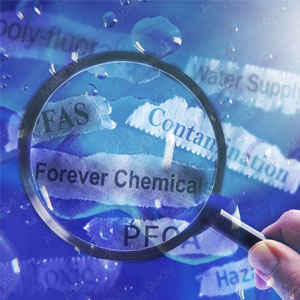Treating the thousands of potentially toxic chemicals called per- and polyfluoroalkyl substances (PFAS) as a single class could reduce health risks and contamination, and improve clean-up efforts, according to a June 30 commentary by an international group of experts.
The article was published in Environmental Science and Technology Letters. It was selected as an American Chemical Society Editors’ Choice publication, making it freely available to the public. Co-authors include NIEHS Scientist Emeritus Linda Birnbaum, Ph.D., and Mark Miller, Ph.D., chief of staff in the institute’s Office of the Director. Carol Kwiatkowski, Ph.D., from North Carolina State University, is the lead author.
 Birnbaum served as NIEHS and National Toxicology Program Director for more than 10 years, and as a federal scientist for more than 40 years. She retired in 2019. (Photo courtesy of Steve McCaw)
Birnbaum served as NIEHS and National Toxicology Program Director for more than 10 years, and as a federal scientist for more than 40 years. She retired in 2019. (Photo courtesy of Steve McCaw)“Managing PFAS one-by-one is neither feasible nor cost-efficient,” the scientists wrote. “More comprehensive solutions are needed, given that traditional approaches have failed to control widespread exposures to PFAS and resulted in inadequate public health protection. We suggest class-based options to more comprehensively and efficiently reduce PFAS exposure.”
Pressing health issue
Elevated levels of PFAS in human blood have been associated with many human health concerns, including immune suppression and adverse developmental effects. According to the authors, other potential consequences include the following:
- Increased risk of kidney and testicular cancer.
- Elevated cholesterol.
- Liver disease.
- Decreased fertility.
- Thyroid problems.
- Changes in hormone functioning.
Animal studies support the associations seen in humans and show PFAS can cause a range of biological issues, the scientists noted. Also, widespread environmental contamination means large populations are exposed to the substances (see sidebar). But despite their known risks, authorities test for fewer than 50 of the PFAS that are in the environment. To date, less than 1% of all PFAS have been evaluated for toxicity.
“Proceeding with the approach of testing one chemical at a time will cause substantial delays in the effort to protect health and the environment from this large class of potentially hazardous chemicals,” the authors wrote.
Treating PFAS as a single class
The authors propose eliminating all nonessential use of PFAS, based on input from scientists, industry, and policymakers. Their proposed single-class approach should apply to fluorinated polymers, too. Those large molecules are PFAS precursors responsible for the release of greenhouse gases and extensive environmental contamination.
 From 2007 to 2019, Kwiatkowski directed the Endocrine Disruption Exchange, a nonprofit research institute dedicated to reducing the production and use of hormone-disrupting chemicals. (Photo courtesy of Carol Kwiatkowski)
From 2007 to 2019, Kwiatkowski directed the Endocrine Disruption Exchange, a nonprofit research institute dedicated to reducing the production and use of hormone-disrupting chemicals. (Photo courtesy of Carol Kwiatkowski)The researchers listed several advantages of managing PFAS as one category of chemicals. For example, chemical and product manufacturers would avoid substituting PFAS known to be hazardous with less-well-known PFAS that are structurally similar and equally hazardous. The authors hope the move would encourage innovation in the development of safer, more easily degradable alternatives and bolster government-led cleanup efforts.
For those changes to occur, further development and implementation of standardized, accurate methods for measuring total PFAS are needed, the scientists noted. Simple, low-cost monitoring would support more frequent testing of water, food, products, and the environment. In turn, that would improve the detection of emerging risks and compliance with rules regarding PFAS.
“The more we study PFAS, the more we learn about the harm they can do to our health and the environment,” the authors wrote. “Managing PFAS as a class is scientifically sound, will provide business innovation opportunities, and will help protect our health and environment now and in the future.”
Citation: Kwiatkowski CF, Andrews DQ, Birnbaum LS, Bruton TA, DeWitt JC, Knappe DRU, Maffini MV, Miller MF, Pelch KE, Reade A, Soehl A, Trier X, Venier M, Wagner CC, Wang Z, Blum A. 2020. Scientific basis for managing PFAS as a chemical class. Environ Sci Technol Lett doi: 10.1021/acs.estlett.0c00255.
(Janelle Weaver, Ph.D., is a contract writer for the NIEHS Office of Communications and Public Liaison.)









